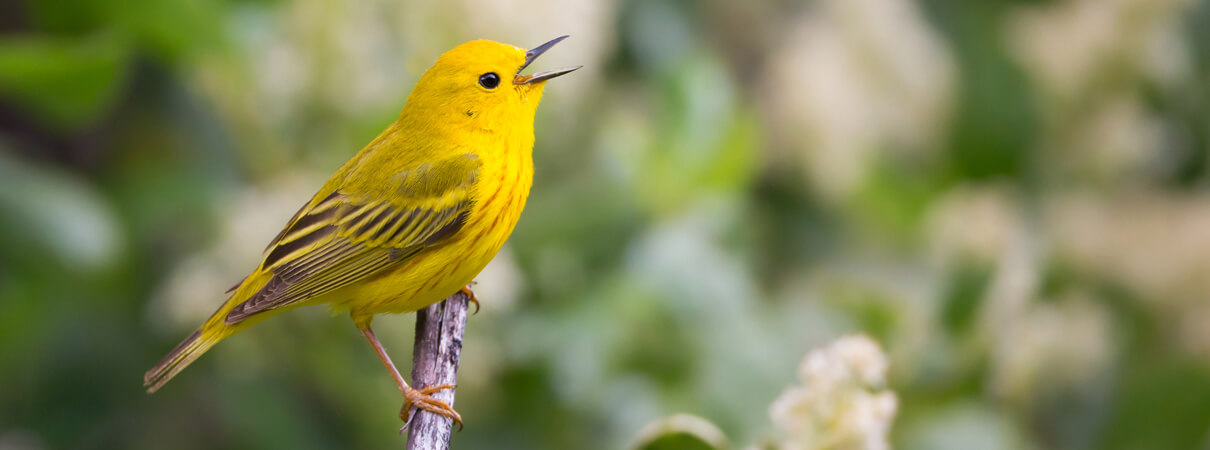A Life Shaped by Bird Migration
The years have rolled by, leaving me with many memories touched by migrating birds. I still remember my first glimmer of understanding of the bird migration phenomenon. I was nine or ten years old and had spotted a male Yellow Warbler in spring plumage.

Yellow Warblers nest throughout much of North America, and winter in Central America and northern South America. Photo by Double Brow Imagery/Shutterstock
Although I had passing familiarity with the year-round and wintertime birds at home, this springtime beauty was new to me. I went to my father for an explanation of how I had missed this bird before.
Dad explained bird migration, a talk that lit a small fire in me that has never been extinguished.

Tundra Swans travel in flocks while migrating and during the winter months, but separate into breeding pairs when they return to the Arctic tundra to breed each summer. Photo by Delmas Lehman/Shutterstock
A decade later, in 1971, I crawled on hands and knees up a grassy North Dakota hillside, trying to sneak up on Whistling Swans (as Tundra Swans were called then) with numbered neck collars. These collars—used decades before today's tiny geolocators—were the best available way to piece together the migration story for swans.
Suddenly the sky was filled with Sandhill Cranes; thousands of them, wings set for landing across the hill. I no longer remember what collars I read that day, but I do remember watching the cranes arrive for more than an hour, and remaining another hour listening to the haunting calls of the cranes and swans together, just out of sight. That's the wonder of bird migration!

During migration, Sandhill Cranes gather in flocks that can number in the tens of thousands. Photo by Mark Herreid/Shutterstock
The years have rolled by, leaving me with many memories touched by migrating birds. Tracking a Golden Eagle with a radio on its back through downtown Milwaukee. Walking down the Cape May beach each afternoon to watch the Least Tern colony. The thrill of seeing “our” migrants leave Colombia to pour back north.
And, on a recent summer evening, standing outside my home in Virginia to listen to the Wood Thrush songs slowly change to call notes, followed by the silence that comes with dusk. Bird migration tells the chronicle of my life, made more poignant by their steady lessening through the years.

Although still relatively common, Wood Thrush populations declined by more than 60 percent in the years between 1966 and 2015. Photo by Ryan Sanderson
So, here I am at ABC, doing my small part to keep alive the world's most astounding bird migration phenomenon. We all know the threats: mostly loss of habitat due to unsustainable population growth, compounded by overconsumption, geopolitics, and sometimes indifference.
There are many resulting questions: Will our beach-breeding birds survive the increasing pressure on beaches? Will the historic development of improved relations between the U.S. and Cuba nonetheless result in the loss of habitats so important to many migratory species such as the Black-throated Blue Warbler?
And will Congress strengthen or weaken the Migratory Bird Treaty Act, America's most important law protecting migratory birds?
Please sign our Together for Birds petition to keep laws protecting migratory birds strong!

Black-throated Blue Warblers nest in the deep forests of eastern North America and winter in Cuba, the Caribbean, and Central America. Photo by Paul Jones
Help us protect the places that migratory birds need to survive. Click here to donate.
We must address each of these concerns and a thousand more, but we cannot be daunted by their complexity. Though I haven't space here to explain ABC's bold new plans to bring back the migratory birds, know that we are working in key areas—which we call “Birdscapes,” short for critical landscapes for bird migration—and that we will succeed simply because we must.

George Fenwick, President, American Bird Conservancy
Editor's note: This article first appeared in the fall 2016 edition of Bird Conservation magazine.


















































